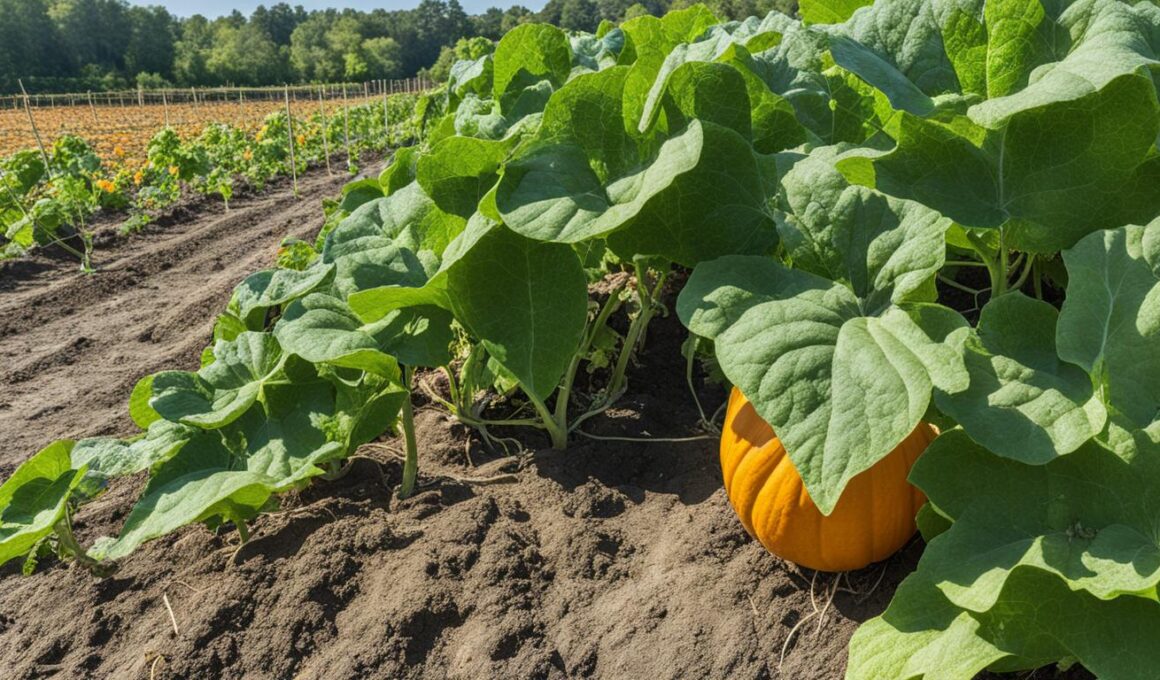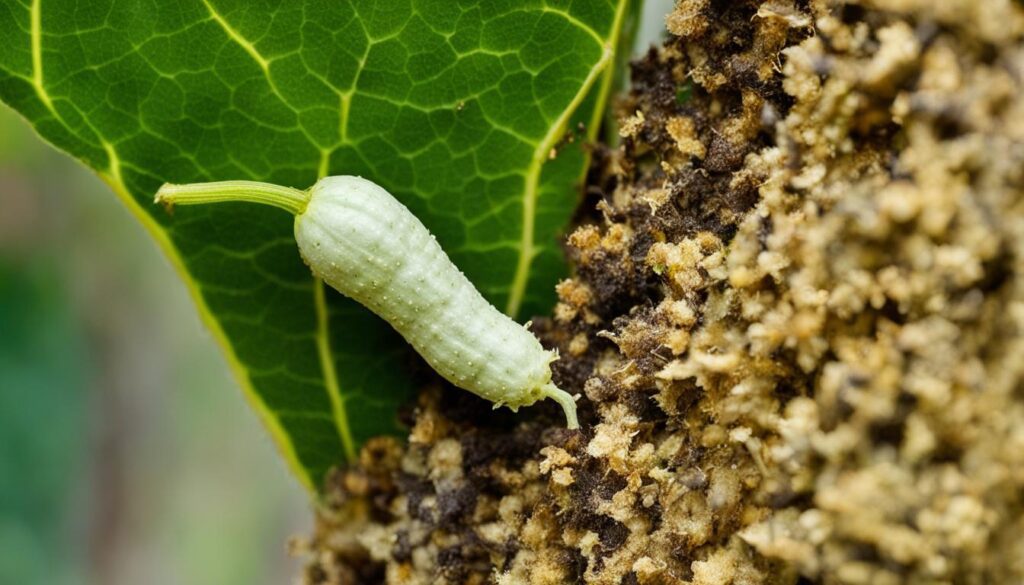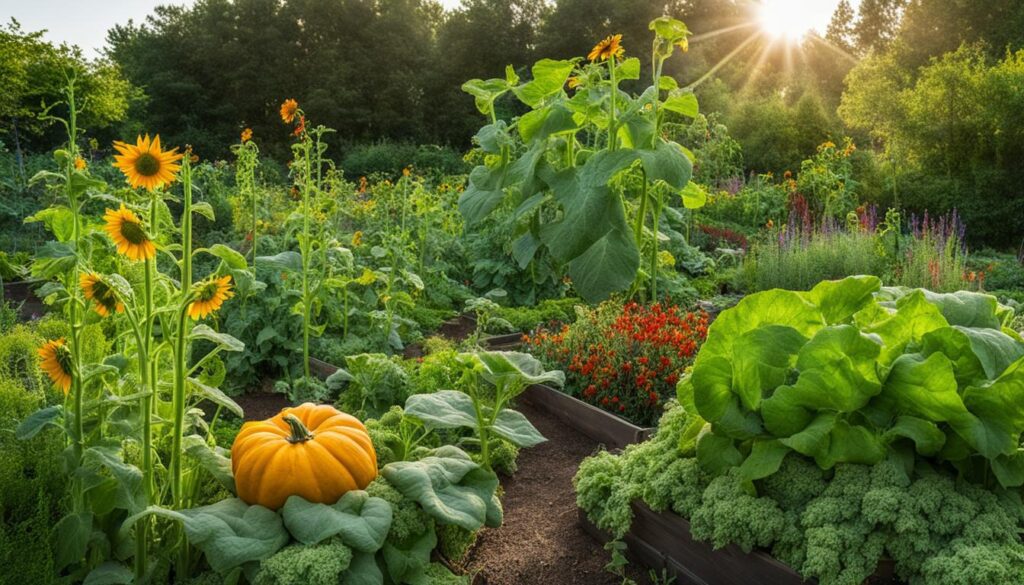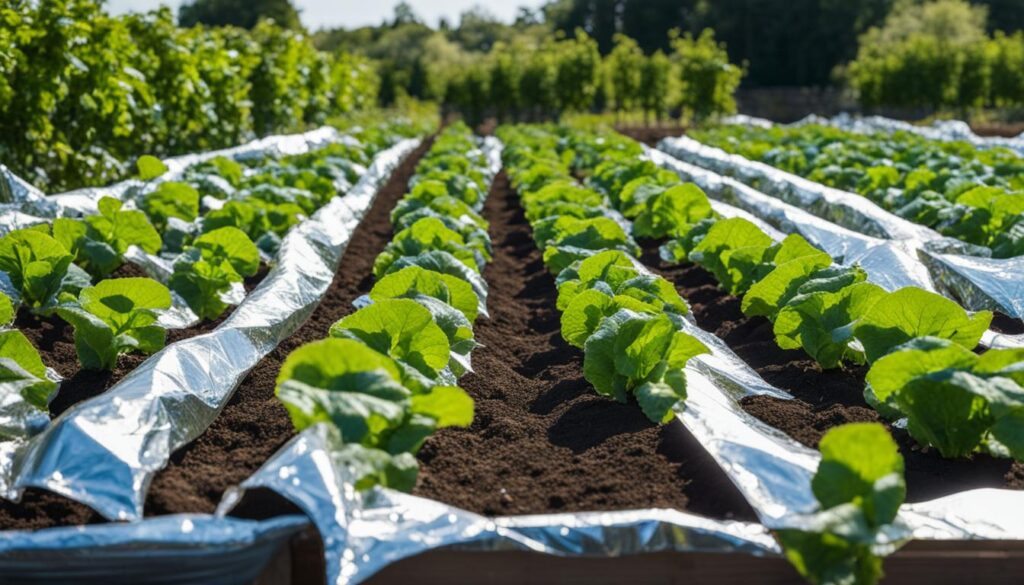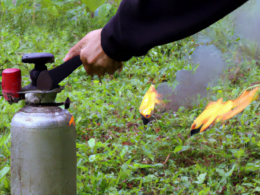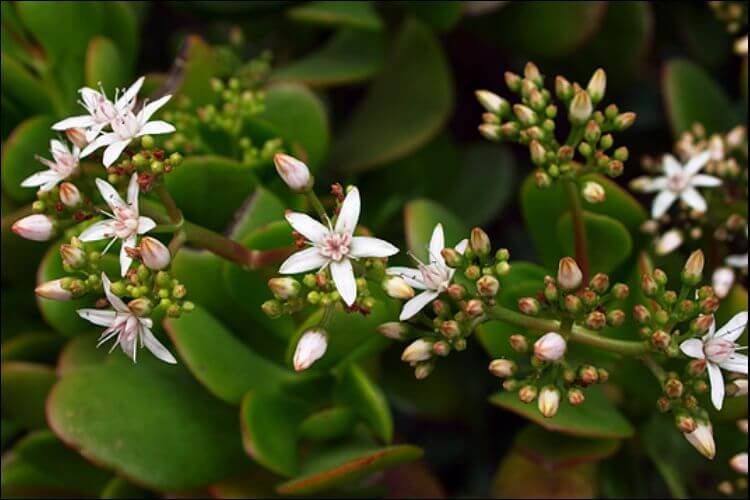Squash vine borers can wreak havoc on your garden, causing wilting and even death to your prized plants. But fear not! With a few expert tips and preventive measures, you can stop vine borers in their tracks and protect your plants from their destructive ways.
Squash vine borers are relentless pests that bore into the stems of squash and other gourd plants. To prevent their damage and maintain a flourishing garden, it’s important to understand their lifecycle and implement effective strategies.
Key Takeaways:
- Timing your plantings, practicing crop rotation, and using companion plants can help prevent vine borer infestations.
- Foil wrapping and row covers act as physical barriers, making it difficult for vine borers to attack your plants.
- Consider planting resistant squash varieties to reduce the risk of damage from vine borers.
- Organic pest control methods, such as manual removal and introducing beneficial insects, can help manage vine borer populations.
- By following these expert tips, you can safeguard your plants and enjoy a thriving garden free from the damage caused by vine borers.
Identifying Squash Vine Borers and their Damage
When it comes to protecting your squash and gourd plants from the destructive effects of vine borers, early identification is crucial. Squash vine borers are orange and black moths that lay their eggs at the base of squash plants. These eggs eventually hatch into larvae that burrow into the stems, cutting off the flow of water and nutrients. The first sign of infestation is often wilting or yellowing of leaves, which can quickly progress to plant death.
To confirm the presence of vine borers, look for frass, which is sawdust-like excrement, at the base of the plant. This is a clear indication that the larvae have bored into the stem. Additionally, you may notice entry holes or sawdust-like material near the base of the plant. It’s important to note that by the time these symptoms are visible, it may be too late to save the plant.
Signs of Squash Vine Borer Infestation:
- Wilting or yellowing leaves
- Frass (sawdust-like excrement) near the base of the plant
- Entry holes or sawdust-like material near the base of the plant
Being able to identify the signs of squash vine borer infestation is the first step in effectively combating these pests. By taking prompt action, you can protect your plants and minimize the damage caused by vine borers.
Prevention Tips: Timing and Succession Planting
Preventing vine borers is a crucial step in safeguarding your squash and gourd plants. One effective method is to adjust your planting schedule. By delaying the planting of zucchini and other susceptible plants until mid-July or later, you can avoid the peak emergence period of adult vine borers. This reduces the risk of eggs being laid on your plants, giving them a better chance of survival.
Another approach is to adopt succession planting. This involves planting a new crop of squash every few weeks. By staggering your plantings, you ensure that if one plant becomes infested with vine borers, you have others at different stages of growth that may be less attractive to the pests.
Succession planting also extends your harvest season, providing a continuous supply of fresh squash throughout the summer. This technique is not only effective for managing vine borers but also helps to maximize your overall vegetable yield. So, if you want to stay one step ahead of vine borers, adjust your planting timing or embrace the concept of succession planting!
Crop Rotation and Companion Planting
One effective preventive measure against squash vine borers is crop rotation. By avoiding planting squash or other susceptible plants in the same area for several years, you disrupt the life cycle of the vine borers, reducing the chances of reinfestation. This practice is especially important because vine borer eggs and larvae can overwinter in the soil. By rotating your crops, you create a less favorable environment for them to thrive.
In addition to crop rotation, companion planting can also help repel vine borers and protect your squash plants. Certain plants, such as nasturtiums, mint, and radishes, have scents that naturally repel vine borers. By interplanting these companion plants with your squash, you can create a deterrent effect. Plus, these companion plants can also help deter other unwanted pests from your garden, providing an added benefit.
When implementing companion planting, consider interspersing these repellent plants throughout your squash bed. This way, their scents can help mask the attractant odors of the squash plants, making them less appealing to the vine borers. Additionally, companion planting promotes biodiversity in your garden, which can lead to a healthier and more balanced ecosystem, ultimately benefiting your squash plants and other crops.
Companion Planting Tips:
- Plant nasturtiums around the perimeter of your squash bed to create a barrier that discourages vine borers from approaching.
- Interplant mint throughout your squash bed to release its strong scent and repel vine borers.
- Grow radishes as a sacrificial crop, attracting vine borers away from your squash plants.
- Consider planting these companion plants in clusters rather than single plants to enhance their repellent effect.
Foil Wrapping and Row Covers
When it comes to protecting your plants from squash vine borers, two effective methods are foil wrapping and the use of row covers. These strategies create physical barriers that make it difficult for the larvae to reach and damage your plants.
Foil wrapping involves carefully wrapping aluminum foil around the base of the plants, creating a barrier that the vine borer larvae struggle to chew through. Make sure to wrap the foil snugly around the stem and extend it below the soil surface to prevent the pests from finding an entry point. This method is particularly useful for individual plants or small garden beds.
Row covers, on the other hand, are lightweight fabric covers that can be placed directly over your plants. These covers not only protect against vine borers but also offer defense against other pests. However, keep in mind that row covers can prevent pollinators from accessing the flowers, so manual pollination may be necessary to ensure fruit set.
Using foil wrapping or row covers can significantly reduce the risk of squash vine borer infestation and help you maintain healthy plants throughout the growing season.
Advantages of Foil Wrapping and Row Covers:
- Foil wrapping provides a physical barrier that prevents vine borers from burrowing into the stems of your plants.
- Row covers offer protection against a range of pests, not just vine borers.
- Both methods are inexpensive and easy to implement, making them accessible to all gardeners.
By incorporating foil wrapping or row covers into your pest management strategy, you can increase the chances of a successful harvest and enjoy healthy, borer-free plants.
Planting Resistant Varieties
If you are dealing with severe vine borer infestations, consider planting squash varieties that are naturally resistant to them. These resistant varieties can help protect your plants and reduce the risk of damage.
Resistant Squash Varieties
- Cucurbita Moschata Squash: Cucurbita moschata squash, including butternut squash, is known for its resistance to vine borers. These varieties have a tough stem that makes it difficult for the larvae to burrow and cause damage.
- Zucchini Rampicante: Zucchini rampicante is another resistant squash variety that can be grown as both summer and winter squash. It has a vining habit and produces long, cylindrical fruits.
- Tromboncino Squash: Tromboncino squash is a climbing Italian heirloom variety that is resistant to vine borers. It has a unique curved shape and can be harvested as a summer squash when young or left to mature into a winter squash.
By choosing these resistant varieties, you can add an extra layer of protection to your garden and increase your chances of a successful harvest. Remember to follow proper planting and care techniques to maximize the benefits of these resistant varieties.
Organic Pest Control Methods
When it comes to combating vine borers, organic pest control methods can be an effective and eco-friendly solution. By utilizing these methods, you can manage vine borer populations without the use of harmful chemicals or pesticides. Here are a few strategies to consider:
- Manual removal of vine borer grubs: One method is to physically remove the vine borer grubs from the stems of your plants. Carefully slit the stem and extract the larvae by hand. This method is most effective for small infestations, so regular monitoring is important to catch the pests early.
- Beneficial insects for vine borer control: Introducing natural predators to your garden can help control vine borer populations. One such predator is the parasitic wasp, which preys on vine borer eggs and larvae. These wasps can be purchased from garden supply centers and released into your garden to target the pests.
Additionally, organic insecticides can be used to combat vine borers. One example is Bacillus thuringiensis (Bt), a naturally occurring bacteria that specifically targets and kills certain insect larvae, including vine borers. By applying Bt as a foliar spray, you can effectively target vine borer eggs before they hatch.
Quote:
“Organic pest control methods offer a safe and environmentally friendly approach to managing vine borers. By embracing manual removal, beneficial insects, and organic insecticides, you can effectively control these pests and protect your plants.”
Implementing these organic pest control methods in combination with preventive measures can significantly reduce the impact of vine borers on your garden. By taking a proactive approach and utilizing these strategies, you can maintain a healthy and productive garden without relying on harmful chemicals.
Conclusion
Squash vine borers can be a major nuisance in the garden, but with the right preventive measures and organic pest control methods, you can effectively stop them and protect your plants. Timing your plantings, practicing crop rotation, using companion plants, and implementing physical barriers like foil wrapping and row covers are all effective strategies.
Additionally, planting resistant squash varieties and using organic pest control methods can further enhance your success in combating vine borers. By following these expert tips, you can enjoy a thriving garden free from the damage caused by these pests.
What are the most effective methods for stopping vine borers?
If you are looking for ways of preventing vine borers today, consider using row covers to protect your plants and removing any infested plants or vines promptly. Additionally, rotating your crops and practicing good garden hygiene can help to reduce the risk of vine borer infestations in the future.
FAQ
What are squash vine borers?
Squash vine borers are larvae of orange and black moths that bore into the stems of squash and gourd plants, causing wilting and eventually death.
How can I identify squash vine borers?
Look for orange and black moths laying eggs at the base of squash plants. Infested plants will show wilting and the presence of sawdust-like excrement (frass) at the base.
How can I prevent squash vine borers?
Delay planting until mid-July or practice succession planting. Implement crop rotation, use companion planting with repellent plants, and wrap aluminum foil or use row covers as physical barriers.
What are some resistant squash varieties?
Cucurbita moschata squash (including butternut squash), Zucchini rampicante, and Tromboncino squash are known for their resistance to vine borers.
Are there organic pest control methods for vine borers?
Yes, manual removal of larvae, introducing beneficial insects like parasitic wasps, and using organic insecticides like Bacillus thuringiensis (Bt) can help control vine borers.





